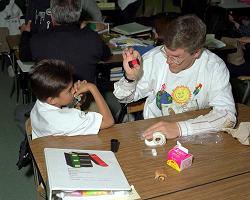
To convey key climate change concepts effectively, it is vital to be aware of fundamental misconceptions about climate, which are widespread. According to a 2011 report from the Yale Project on Climate Change Communication, 46% of adults, and 54% of teenagers, in the United States would not receive a passing grade if quizzed on the basics of climate. Yet at least 60% of adults, and 50% of teenagers, thought that they were “fairly well informed” or “very well informed” on the topic.
Here are a few examples of common misconceptions relevant to climate science that science teachers may encounter in their students:
- The Earth gets closer to the Sun in summer and is further away in winter. In fact, axial tilt is the primary “reason for the seasons”.
- Air is intangible and doesn’t have any effect on anything. In fact, air is made of various gases; it has mass and occupies space.
- Plants derive mass from water and nutrients drawn up through their roots. In fact, plants gain most of their mass from carbon dioxide through photosynthesis.
- Climate is simply long-term weather and can’t be predicted over long periods of time. In fact, weather and climate, while related, are driven by different processes and are studied using different methods and models.
- Small amounts of CO2 in the vastness of the atmosphere can’t change climate. In fact, small alterations in atmospheric composition of temperature can have large and nonlinear effects.
Research has found (and the experience of many teachers will confirm) that such misconceptions are not easily dislodged. When introducing a new scientific concept, teachers should first:
- understand the potential misconceptions
- uncover the misconceptions that their students actually have — the forthcoming assessment items for weather and climate, from the AAAS’s Project 2061, are useful here
- avoid reinforcing the misconceptions by devoting attention to them
Teachers then need to provide learning situations that will enable their students to replace their misconceptions with the correct understanding of the scientific concept. In these situations, students are required to apply the concept in thinking about how to answer a question or solve a problem, ideally one with clear real-world relevance. The students are thus given the opportunity to test the usefulness of their prior conceptions and compare them to the usefulness of the correct understanding of the concept.
There are various teaching methods that help to dislodge student misconceptions — often involving visualizations, interactions, or laboratory activities — and teachers may differ in their preferences and abilities to use them. But research indicates that, for topics where misconceptions are prevalent and profound, teaching by rote and multiple-choice testing is not effective in ensuring that students retain what they have learned in their science classes. So the use of effective teaching methods aimed specifically at helping students attain the correct understanding of scientific concepts is especially necessary in teaching about climate change.
The links in Resources for Teaching and Learning about Climate Change provide more information especially useful for educators. Or continue to the next section, and find out how to go about addressing doubt and denial in the classroom.
